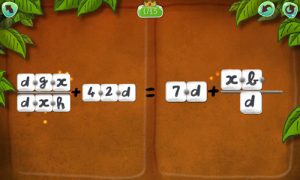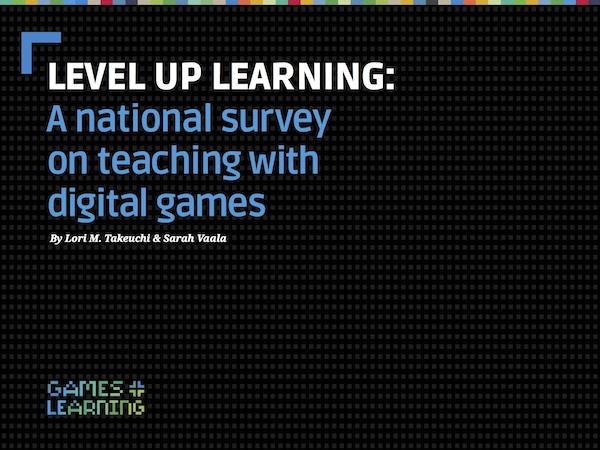In the part two of a roundtable discussion on teaching with games, Sandhya Nankani talks to Paul Darvarsi and Aleksander Husoy about what teachers look for in learning games and explore some of the qualities that make the teaching games successful. See part 1 here.
Teachers on games for learning
 Sandhya: A recent study found that 91 percent of children in the United States ages 2-17 play video games! What an opportunity they present as a tool for learning, right? It makes sense, therefore, that so many organizations and media companies that create children’s content will at some point explore the possibility of creating a learning or classroom game.
Sandhya: A recent study found that 91 percent of children in the United States ages 2-17 play video games! What an opportunity they present as a tool for learning, right? It makes sense, therefore, that so many organizations and media companies that create children’s content will at some point explore the possibility of creating a learning or classroom game.
I’ve created history games, STEM-education games, literacy games, and social impact games over the last several years. As a content creator and narrative designer of learning games, one of the things I’ve struggled with most is understanding how the games that I’m helping to create will eventually fit into the busy classroom of today. My challenge, over and over again, is to help game designers who want to deliver a fast-paced, engaging game to create a narrative rich in content that supports learning outcomes and educational standards. Sometimes, I’m brought into a project late in the game or after the mechanics have been determined. Other times, I’m asked to create a curriculum or lesson plan to support a game’s use in the classroom without much information about how the game will be marketed or who the core audience of educators using it will be.
I agree with you both about the value of games, but there are times that I worry that game-based learning can be the future if and only if games are created in a spirit of collaboration with teachers, with educational outcomes in mind, and can provide flexibility of use. As teachers in the trenches and as gamers yourselves, what are the core benchmarks that you think game creators, publishers, and developers should be thinking about when creating “games for learning”?
What do you think potential game creators need to consider before beginning or committing to creating educational games? What do you think educational games are missing today?
 Aleks: I think you are spot on regarding the importance of quality collaborations between the different parties taking part in the development and distribution of learning games. From my point of view, as a teacher who has never taken part in the development process of any game, many ed-games suffer from the same basic limitations:
Aleks: I think you are spot on regarding the importance of quality collaborations between the different parties taking part in the development and distribution of learning games. From my point of view, as a teacher who has never taken part in the development process of any game, many ed-games suffer from the same basic limitations:
- A costly educational game needs to appeal to a wide target audience in order to justify their cost. Often this leads to games where the content is too complex for younger learners, while gameplay isn’t sufficiently challenging for older learners.
- Game developers are not sufficiently conscious of the context in which the game should be used. If you are making a game to be played by a child at home independently, in partnership with a parent, or in a specific type of classroom context, then you need to make widely different design choices.
- Games are often designed with a very specific curricular goal in mind, with little room for flexibility. This limits teachers’ options in designing a game-centered unit that caters to the unique needs of their class.
- The various parties that take part in a game development process do not understand each other’s fields well enough. It seems to me that in many cases, organizations will commission a game without sufficient knowledge of possibilities and limitations in game design, game designers will have a limited understanding of pedagogy, and teachers are often unfamiliar with various game genres. Though all parties are well intentioned and experts in their own field, a successful ed-game requires extensive collaboration early on in the game design process.
I am optimistic that the quality of educational games coming out is improving, but at this point in time there are few ed-games that can compete with commercial games for consideration in my classes.
 Paul: Like Aleks, I generally look to commercial video games for my classroom because they tend to be more engaging and complex than games specifically designed for learning. With many educational games, the gameplay is secondary to the learning goals, which puts the cart ahead of the horse. Chess can teach strategy, analysis, foresight, planning, etc., but it wasn’t designed with those goals in mind. It was made to challenge and entertain, and learning naturally follows. An ed-game should be a “good game” first and foremost. Determining what qualifies as “a good game” is not easy, but if it’s challenging and fun to play, you’re probably on the right track. The good news is that the industry has matured, the technology improved, and game designers are becoming more savvy. Consequently, there are more dedicated learning games being developed that are genuinely engaging. A good recent example is Dragonbox, which kids find entertaining, but also helps them develop a basic understanding of algebra.
Paul: Like Aleks, I generally look to commercial video games for my classroom because they tend to be more engaging and complex than games specifically designed for learning. With many educational games, the gameplay is secondary to the learning goals, which puts the cart ahead of the horse. Chess can teach strategy, analysis, foresight, planning, etc., but it wasn’t designed with those goals in mind. It was made to challenge and entertain, and learning naturally follows. An ed-game should be a “good game” first and foremost. Determining what qualifies as “a good game” is not easy, but if it’s challenging and fun to play, you’re probably on the right track. The good news is that the industry has matured, the technology improved, and game designers are becoming more savvy. Consequently, there are more dedicated learning games being developed that are genuinely engaging. A good recent example is Dragonbox, which kids find entertaining, but also helps them develop a basic understanding of algebra.

Aleks: Dragonbox is a star example of an educational game that does things right. In addition to the point raised by Paul that it’s genuinely entertaining in its own right, Dragonbox has succeeded in one core area where many ed-games fall short. In many learning games, there is a weak link between game mechanics and learning objectives. Very often the educational component of the game is presented through quizzes, text boxes, and cut-scenes that function as obstacles that must be breached to get back to the fun stuff. In Dragonbox the learning objectives are finely interwoven in the game mechanics and close to every action the learner takes is directly related to the concept (algebra) that is meant to be taught.
Games don’t have to be digital
Sandhya: It’s nice to talk about the value of digital games but we must recognize that opportunity does not exist for all, as this research from the Joan Ganz Cooney Center shows. In our inequitable world where many homes and classrooms remain low-tech, I’m often thinking about how games can still be integrated. I think the Quest to Learn schools in New York and Chicago, which are based entirely on game principles, are a great model. There, 90% of the games used in the classroom are board games or physical games. What are your thoughts on how game-based learning can be integrated into schools that do not have digital resources?
Paul: The digital divide is certainly a problem in contemporary education, but game-based learning is not wholly dependent on technology. Video games are a good addition to the classroom repertoire, but learning can occur through a game created from bottle caps and an egg carton. Creative use of available resources can help leverage the principles of game-based learning without technology.
Video games have taught us a great deal about engaging players, including the use of choice and agency, accommodating individual skill levels, the importance of balancing intrinsic and extrinsic motivation, and achieving success through challenges and failures. Can these lessons be used to inspire changes to traditional teaching and learning systems in schools and classrooms? We must continue to work towards creating more equitable access to resources, however it’s important to think not only about using games, but also adopting game-mindedness to more broadly improve education.
Aleks: Though most of my career in education has been spent in technology-rich environments, many of the principles that we apply to digital games can also be applied in low-tech classrooms. Though as Paul states, unequal access to technology expands the educational divide between the haves and the have-nots, games and playful learning are not wholly dependent on electronic gadgets. My “gateway drug” to using video games in my classes was an interest in roleplay and simulations, which in many cases can serve the same purpose as digital games in the classroom.

For classrooms that have some access to some technology, one should also be aware that students do not necessarily need separate copies of games and devices. This year, I’m running a unit on parliamentary democracy where we use the game Democracy 3 as a backdrop. The game, which is essentially a simulator of the political decision-making process, serves as a backdrop for a primarily “non-digital” model parliament session. The same kind of thinking can be applied to a range of games, keeping in mind that though games may facilitate learning, the most important interactions are those that take place between learners, not between learners and the game. Regardless of whether one has 1-to-1 access to devices, a single computer, or no access to digital technology whatsoever, creative teachers can always find ways of using games or game principles in their teaching.
Getting games into the classroom
Sandhya: What kinds of games would you like to see created that would be super useful to you as educators for today’s kids?
Aleks: I’m going to highjack this question to answer something somewhat related, yet completely off-topic.
The games that are super useful to educators do already exist. Teachers with an understanding of the potential of using games in education already have an enormous library to select from. Getting quality games into classrooms is remains a challenge. While there are systems in place for schools that want to purchase text books, literature, films, and many other learning supplies, teachers interested in using games not initially intended for use in education need to navigate a bureaucratic, logistical, technical, and legal maze in order to get games for their classroom. What would be super useful to me would be a distribution channel that allowed me to buy and get started using a game quickly, and thereby afford me more time to develop better pedagogy.
Sandhya: Where do you find the learning games that you use?
Paul: I find games in all sorts of places. Many of the games I’ve used in the classroom I’ve discovered through social media. I follow GBL educators, game developers, game scholars, and various game culture sites, which keeps me somewhat up-to-date on new releases and potential classroom uses for existing games. Organizations like Common Sense Media curate extensive game review sites for parents and teachers, and YouTube shows like Extra Credit have done valuable work examining the intersections of games and education.
Aleks: Though there is a growing movement within the teaching field towards using games in classroom, most schools have a limited number of “gamer teachers”. Both Paul and I have drawn great benefit from our “expanded teachers’ lounges” on social media. In Scandinavia we have a large Facebook community related to games, education, and playful learning, which has generated a trove of ideas for both developing games and (more importantly) various approaches to using games. The Norwegian Centre for ICT in Education, an agency of the Department of Education, also publishes quality guides to games for use in school.
 Paul Darvasi teaches high school English and media studies at Royal St. George’s College in Toronto, Ontario and is a game designer and PhD candidate in York University’s Faculty of Education. He has recently authored How Digital Games Can Support Peace Education and Conflict Resolution.
Paul Darvasi teaches high school English and media studies at Royal St. George’s College in Toronto, Ontario and is a game designer and PhD candidate in York University’s Faculty of Education. He has recently authored How Digital Games Can Support Peace Education and Conflict Resolution.
 Aleksander Husoy teaches English and Social Science at Nordahl Grieg Upper Secondary School in Bergen, Norway and is a teacher-instructor and advisor for the Norwegian Centre for Information and Communication Technology in Education.
Aleksander Husoy teaches English and Social Science at Nordahl Grieg Upper Secondary School in Bergen, Norway and is a teacher-instructor and advisor for the Norwegian Centre for Information and Communication Technology in Education.
 Sandhya Nankani is a children’s media producer who has created content and narrative design for “educational” games, including the recently launched World Rescue, inspired by the United Nations Sustainable Development Goals.
Sandhya Nankani is a children’s media producer who has created content and narrative design for “educational” games, including the recently launched World Rescue, inspired by the United Nations Sustainable Development Goals.


